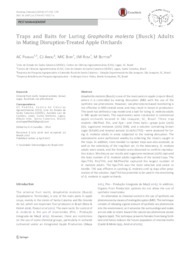Traps and baits for luring grapholita molesta (Busck) adults in mating disruption-treated apple orchards.
Traps and baits for luring grapholita molesta (Busck) adults in mating disruption-treated apple orchards.
Author(s): PADILHA, A. C.; ARIOLI, C. J.; BOFF, M. I. C.; BOTTON, M.
Summary: Grapholita molesta (Busck) is one of the main pests in apple crops in Brazil, where it is controlled by mating disruption (MD) with the use of the synthetic sex pheromone. However, sex-pheromone-based monitoring is not effective in MD-treated areas and may result in losses in production. This work has defined a trap model and a bait for luring G. molesta adults in MD apple orchards. The experiments were conducted in commercial apple orchards located in São Joaquim, SC, Brazil. Three trap models " McPhail, Pot, and Ajar " and three baits " grape juice (25%) (GJ), sugarcane molasses (25%) (SM), and a solution containing brown sugar (8.69%) and terpinyl acetate (0.05%) (TAS) " were assessed for lur- ing G. molesta adults in areas subjected to the mating disruption. The assessments were performed weekly by collecting the insects caught in the traps. In addition, time needed to replace traps was also assessed, as well as the selectivity of the trap/bait set. In the laboratory, G. molesta adults were sexed, and the females were dissected to confirm reproduc- tive status. We discuss our results and sugarcane molasses (25%) captured the least number of G. molesta adults regardless of the tested traps. The Ajar/TAS, Pot/TAS, and McPhail/ GJ captured the largest number of G. molesta adults. The Ajar/TAS was the most selective and easier to handle. TAS was efficient in catching G. molesta until 14 days after prep- aration of the solution. Ajar/TAS has potential to be used in the monitoring of G. molesta in apple orchards.
Publication year: 2018
Types of publication: Journal article
Unit: Embrapa Grape & Wine
Keywords: Food bait, Oriental fruit moth, Sex pheromone, Terpinyl acetate, brown sugar
Observation
Some of Embrapa's publications are published as ePub files. To read them, use or download one of the following free software options to your computer or mobile device. Android: Google Play Books; IOS: iBooks; Windows and Linux: Calibre.
Access other publications
Access the Agricultural Research Database (BDPA) to consult Embrapa's full library collection and records.
Visit Embrapa Bookstore to purchase books and other publications sold by Embrapa.

